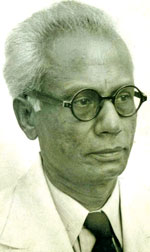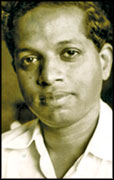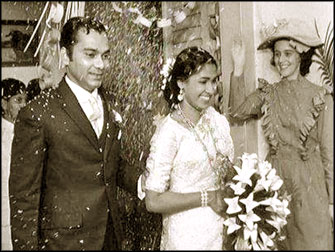|
Gamperaliya a pointer in France:
Glamour of Language of Cinema
Ranga CHANDRARATHNE
`Gamperaliya' which was shown at prestigious Cannes Film Festival
under the category of Cannes Classic and commercially released, for the
first time in France, was polled as the second popular film in France.
It was a watershed in Sri Lankan cinema as it marked Sri Lanka on world
cinema although a commercial failure in Sri Lanka. Earlier, Dr. Lester
James Peries's `Wekande Walauwwa' (Mansion by the Lake) was also
commercially released in France. It is obvious that universal acclaim
for Gamperaliya comes from the fact that it was made by a director well
versed in the language of cinema and creativity.
 |
 |
|
Martin Wickramasinghe |
Dr.
Lester James Peries |
In `Gamperaliya', the film had to stand on its own. It is the plain,
story feel, sense of realism and above all, I would say, the feeling of
truth about characters that came out of this great novel by the great
writer may loose some of the original power in the translation into
another medium. It was released in December 1963 and it was sent to 12th
International Film Festival held in Delhi. The chairman of the jury at
the Film Festival was Satyajit Ray and on the jury there were Lindsey
Anderson, Russian Director and Polish director. The film won Golden
Peacock Award. I won Golden Peacock award twice.
This is the first time `Gamperaliya' has been released commercially
in another country. From what I hear from the distributors in France
that the film has come second in the poll where the popularity is
concerned and second to Clint Eastwood's film, a popular film maker in
France," says Dr. Lester James Peries. Ironical that UNESCO awarded
Felini Gold Medal in 2003 to Dr. Lester James Peries and Clint Eastwood
and today the two films are screened in France.
Based on the Sinhalese novel `Gamperaliya' by legendary Sinhalese
writer Martin Wickramasinghe, the film Gamperaliya was produced in 1963.
The film which won Grand Prix at the Indian Film Festival and was
selected for last year's Cannes Film Festival in its special section
Cannes Classics Restored (CCR) has been restored in America by the
University of South California (UCLA). The restoration Unit at the UCLA
is entirely funded by Packard who are responsible for the restoration of
Gamperaliya. The film was restored as a result of strong recommendation
by a distinguished French critic Pierre Rissient to the visual and audio
perfection by Rob Stone and Jere Guldin.
 |
|
Reggie Siriwardene |
`Gamperaliya' captures the uneasy change the village of Koggala faced
at the tail end of the nineteen century. The film is unique in the sense
that it not only codifies in cinematic terms the socio-cultural
transformation of the milieu but also the emergence of market economy
and middle class of Sri Lanka. Kaisaruwatte's family and Majestic
Walawwa, which is a potent symbol of decaying feudalism, declines
against the backdrop of rise of the new rich portrayed by Piyal.
Unlike the landed gentry, Piyal is English educated and industrious
youngster who subsequently amassed a fortune thanks to emerging market
economy.
Though Nanda was given in marriage to Jinadasa, Jinadasa disappeared
in the face of bleak economic prospects. Nanda marries Piyal symbolizing
triumph of middle class over the landed gentry. It's also the end of
feudal set up. The film Gamperaliya is marked for its non-dramatised
natural cinematic diction and its adherence to the novel.
`Gamperaliya' (Changes in the Village) was released in Sri Lanka in
1964. With an impressive script by Reggie Siriwardene and camera by
William Blake, `Gamperaliya' captured the outdoor scenes in their most
natural form. The music for the film was by W.D. Amaradeva. The cast
comprised Henry Jayasena (Piyal), Punya Hindeniya (Nanda), Wickrema
Bogoda (Tissa), Trilicia Gunawardene (Anula), Gamini Fonseka (Jinadasa),
Shanthi Lekha, David Dharmakeerthi, Tony Ranasinghe and Anula
Karunatilake. The film was produced by Anton Wickremasinghe.
 |
|
A scene from
Gamperaliya: A creative fictionalisation of reality |
When Lester cast Gamini Fonseka for the role Jinadasa, Martin
Wickramasinghe expressed his serious doubt over the selection. He said,
"My God Lester that is not my Jinadasa. He is supposed to be a thin and
quiet man. This one is a boxer."
However, when Wickramasinghe watched the film, he said that in fact
Jinadasa was a far more vivid character than in the book. Among other
things, Gamperaliya won the first ever international award for a Sinhala
film when it was awarded coveted Golden Peacock Award at the Delhi
International Film Festival. Although Lester could not attend the Delhi
International Film Festival, he recalled later in the book Lester by
Lester as told to Kumar de Silva, "I did not go for the festival since I
was shooting some difficult sequences in `Delovak Athara' (1966). I gave
my ticket to Gamini Fonseka, who had acted in the film for free.
" was very happy he was there. Given the circumstances in which film
was financed and made, and the fact that it was one of the finest
international Juries, I thought I missed something which would not
happen for a second time in my life. It did happen miraculously though
in 2000 when the Delhi Film Festival gave me a Golden Peacock for a
`Lifetime Achievement'. Other winners have been Michelangelo Antonioni,
Bernardo Bertolucci and Liv Ulman the actress." |

